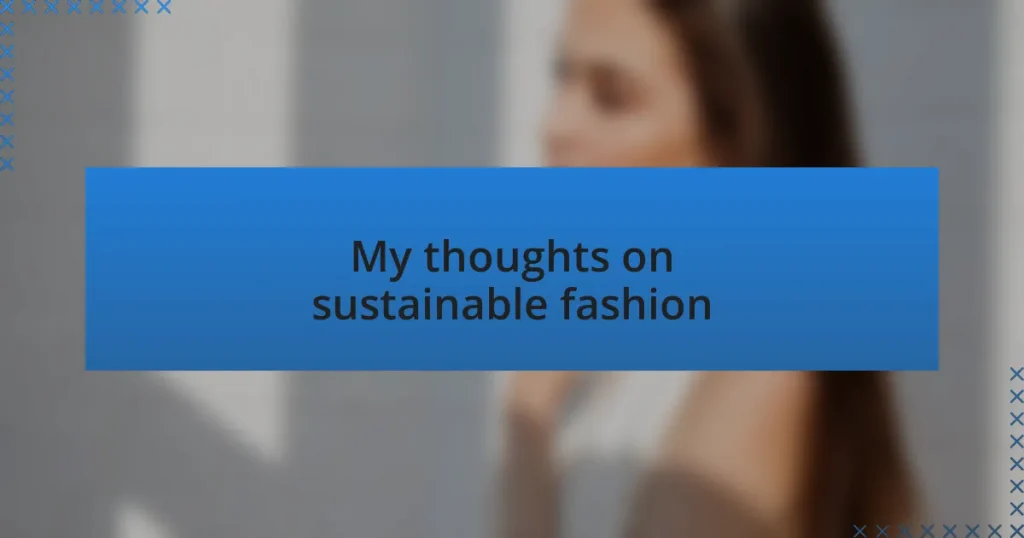Key takeaways:
- Sustainable fashion involves a holistic approach considering the entire lifecycle of clothing, promoting ethical production and quality over quantity.
- It addresses climate change and environmental issues while advocating for fair labor practices in the fashion industry.
- Incorporating sustainable fashion practices includes second-hand shopping, hosting clothing swaps, and researching brands for ethical standards.
- Building a sustainable wardrobe involves mindful purchasing habits, opting for versatile pieces, and repairing rather than discarding worn items.
Author: Charlotte Hawthorne
Bio: Charlotte Hawthorne is an acclaimed author known for her compelling storytelling and richly drawn characters. With a passion for exploring the complexities of human relationships, her novels often blend elements of romance, intrigue, and self-discovery. A graduate of the University of California, Charlotte has received multiple awards for her work, including the prestigious Silver Quill Award. When she’s not writing, she enjoys hiking in the Sierra Nevada mountains and sipping coffee at local cafes. Charlotte currently resides in San Francisco with her rescue dog, Jasper.
Understanding sustainable fashion
Sustainable fashion is about more than just eco-friendly materials; it’s a holistic approach that considers the entire lifecycle of clothing. I remember when I first learned about the environmental impact of fast fashion; it felt like a wake-up call. Realizing that our shopping choices can contribute to waste and pollution made me rethink my wardrobe and encouraged me to value quality over quantity.
The concept also encompasses fair labor practices, emphasizing the need for ethical treatment of garment workers. Have you ever thought about who makes your clothes? When I visited a local ethical brand, I was struck by the pride and skill of the artisans behind the pieces. It deepened my appreciation for fashion and highlighted how every item carries a story.
Moreover, sustainable fashion encourages us to embrace a mindset of mindfulness and intentionality. I found myself asking, “Do I really need this?” before purchasing new items. This shift not only helps reduce my carbon footprint but also nurtures a sense of connection to the items I do choose to keep in my closet.
Importance of sustainable fashion
Sustainable fashion is important because it directly addresses the pressing issues of climate change and environmental degradation. I recall a time when I cleaned out my closet and was shocked to find so many items that I wore only once or twice. With the fashion industry being responsible for a significant amount of global carbon emissions, I’ve become more conscious of my purchases, seeking brands that prioritize sustainability and reduce their environmental impact.
This approach not only helps the planet but also fosters a greater appreciation for the artistry and craftsmanship behind clothing. I once attended a workshop where local designers shared their processes and philosophies on sustainable practices. It inspired me to look beyond mere aesthetics and recognize the value of the resources and labor that go into making our garments.
Choosing sustainable fashion also influences the entire supply chain, advocating for fair wages and safe working conditions for all involved. Have you ever considered the kind of lives your wardrobe choices impact? That’s a thought that resonates deeply with me, prompting me to support brands that align with these values. It’s remarkable how informed decisions can create a ripple effect, positively affecting communities and the environment alike.
Key principles of sustainable fashion
Sustainable fashion hinges on the principle of ethical production, which means ensuring that workers receive fair wages and work in safe conditions. I remember visiting a small local boutique where I met a designer who sourced her materials from fair-trade suppliers. Hearing her story about how each piece of clothing supports a community made me rethink the way I view my purchases. Isn’t it incredible how the clothes we wear can impact someone’s life far beyond our own?
Another crucial aspect is the focus on quality over quantity. I’ve made a habit of investing in timeless, durable pieces that elevate my wardrobe rather than filling it with fleeting trends. For instance, a coat I bought years ago still receives compliments, and I feel great knowing it was crafted to last. How many times have you bought something only to see it lose its charm after a few washes? Prioritizing longevity not only saves money in the long run but also reduces waste in our already burdened landfills.
Lastly, the use of sustainable materials is essential to this movement. I once stumbled upon a clothing line that uses organic cotton and recycled fabrics. The tactile difference was astonishing, and it sparked my curiosity about the environmental impact of conventional textiles. Do you ever think about the materials when shopping? Embracing choices like organic fibers can minimize chemical use and promote a healthier planet. It’s a small shift that can lead to significant change.
Ways to incorporate sustainable fashion
One effective way to incorporate sustainable fashion is to embrace second-hand shopping. I had my reservations initially, thinking that thrift stores were just filled with outdated styles. But my first visit opened my eyes to a treasure trove of unique, high-quality pieces. It’s exhilarating to find a vintage jacket that no one else has, and the thrill of reusing pre-loved items adds a special story to my wardrobe. Ever considered how much history a single garment can carry?
Another approach is to host clothing swaps with friends. I remember organizing one a few months back, and it turned out to be a fantastic way to refresh my closet without spending a dime. We all brought pieces we no longer wore, and by the end of the day, everyone walked away with something “new.” Plus, the fun atmosphere created a sense of community around sustainable choices. Have you thought about who you could invite to join you in this eco-friendly adventure?
Lastly, educating yourself about the brands you support can make a big difference. I’ve started researching the companies behind my favorite pieces to understand their sustainability practices better. It’s empowering to choose brands that prioritize ethics and environmental stewardship. I find myself feeling more connected to my clothes because I know they represent values I care deeply about. Isn’t it fascinating how our choices can reflect our beliefs?
Tips for a sustainable wardrobe
Building a sustainable wardrobe also involves being mindful of your purchasing habits. I recall a time when I used to buy clothing on impulse, often leaving me with items I rarely wore. Now, I take a moment to reflect before making a purchase. I ask myself if I truly need it or if it will fit well with my existing pieces. This small pause has saved me money and countless outfits that I’d simply end up discarding later. Have you ever experienced buyer’s remorse after a shopping spree?
Another great tip is to choose versatile pieces that can be styled in multiple ways. I’ve invested in a few classic staples, like a well-fitting white shirt and a pair of tailored pants, which I can dress up for work or down for casual outings. This not only reduces the number of clothes I need but also allows me to express my style creatively. Isn’t it satisfying to rotate a core set of items and create fresh looks?
Lastly, consider repairing instead of tossing worn items. I remember a pair of jeans I was about to part with because of a small tear. Instead of throwing them away, I took a few minutes to patch them up. Not only did it extend their life, but it also gave me a sense of accomplishment. I think we can all relate to the attachment we form with our favorite pieces. Why not try mending them instead of letting them go?
Resources for sustainable fashion initiatives
When exploring resources for sustainable fashion initiatives, I often turn to platforms like Good On You and Fashion Revolution. These organizations provide invaluable insights into the ethical practices of brands, helping consumers make informed decisions. I remember the first time I discovered Good On You; it felt empowering to have the resources to support brands aligned with my values. Have you ever felt confused about which brands to trust?
I also find immense value in local thrift stores and community swap events. Participating in clothing swaps not only fills my wardrobe with unique finds but also fosters connections within my community. I recall attending a swap last summer, where I exchanged a vintage dress for a chic blazer that quickly became my favorite. It’s thrilling to think that sustainability can be as joyful as a social event. Have you tried swapping clothes with friends or at local events?
Lastly, online platforms like Instagram and Pinterest have become treasure troves of inspiration for sustainable fashion. Following conscious influencers has opened my eyes to creative outfit ideas and eco-friendly brands that I hadn’t known before. I vividly remember scrolling through Pinterest and spotting a DIY upcycle project that motivated me to turn an old t-shirt into a stylish tote bag. Doesn’t it feel great to be both innovative and sustainable?


